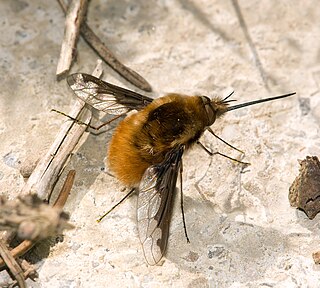
The Bombyliidae are a family of flies, commonly known as bee flies. Adults generally feed on nectar and pollen, some being important pollinators. Larvae are mostly parasitoids of other insects.

Carl Robert Osten-Sacken or Carl-Robert Romanovich, Baron von der Osten-Sacken, Baron Osten Sacken was a German-Russian diplomat and entomologist. He served as the Russian consul general in New York City during the American Civil War, living in the United States from 1856 to 1877. He worked on the taxonomy of flies in general and particularly of the family Tipulidae.

The Mydidae, or Mydas flies, are a cosmopolitan family of flies. It is a small family, with about 471 species described. They are generally large in size, including the largest known fly, Gauromydas heros. Many of the species, in addition to their large size, are mimics of stinging hymenopterans, especially wasps. Most mydids are found in arid and semiarid regions of the world, but they are also found in other habitats.
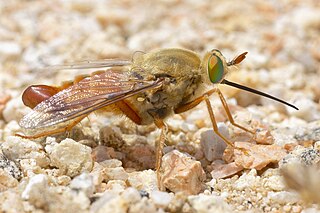
The mydid fly genus Rhaphiomidas contains fewer than 30 species/subspecies, all of them occurring in the desert regions of the southwestern United States and adjacent portions of northwestern Mexico. The adults are most commonly encountered in sand dune areas, and are typically only active for a few weeks each year, either in the spring or the fall; in some cases, more than one species can occur in the same dune system, but they are allochronic, each flying in different seasons. Almost nothing is known about their biology, though eggs or early instar larvae of some species are laid on the soil surface and appear to be attractive to ants, and are brought into the ant nest. The restriction to sand dune areas has unfortunately led a number of these flies to the brink of extinction, especially both subspecies of R. terminatus, and the species R. trochilus. While there is only one of these on the Endangered Species List, many of the remaining taxa - including a few that have not yet been named - are gravely imperiled, as they are restricted to small geographic areas, rendering them extremely vulnerable to habitat loss or disturbance. These habitats are heavily targeted for development, and even if not, activities such as sand mining or motorized off-roading are common, and render the habitat unsuitable for the survival of the flies.
Brennania is a genus of flies in family Tabanidae. It was originally known as Comops, created as a subgenus of Apatolestes by Brennan (1935). Philip (1941) then raised it to genus level, but renamed it to Brennania.

Syrphus is a genus of hoverflies. It can be distinguished from other genera of the tribe Syrphini because it is the only genus that has long hairs on the upper surface of the lower lobe of the calypter.
Procecidocharoides is a genus of tephritid or fruit flies in the family Tephritidae.
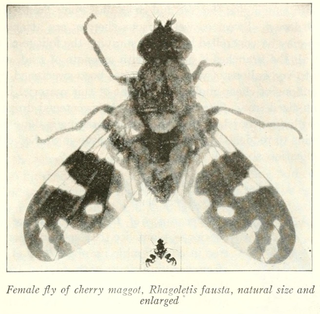
Rhagoletis fausta, the black-bodied cherry fruit fly, is a species of tephritid or fruit flies in the genus Rhagoletis of the family Tephritidae. It is found in the United States and Canada.

Scellus is a genus of flies in the family Dolichopodidae. It is distributed in the Palearctic and Nearctic.
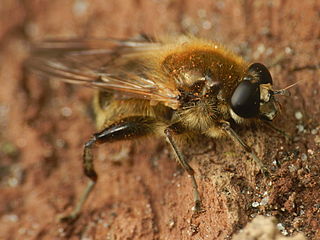
Brachypalpus is a genus of hoverflies, from the family Syrphidae, in the order Diptera. The head is triangular and produced well forwards and somewhat downwards. The thorax and abdomen with pile often rather long. The hind femur is swollen and with an obtuse spur apically and ventrally. The hind trochanters of male is spurred.
The larvae are of the rat-tailed type feeding on decaying sap under tree bark. Larvae live in decaying trees and logs. Larva and pupa have been described by Malloch.
Eutreta diana is a species in the family Tephritidae, known as fruit flies in North America and picture wing flies in Europe. Females lay eggs in vegetative buds of several species and subspecies of sagebrush in western North America. Larvae induce woody galls near their oviposition site and feed on the plant internally until they mature. Adults have "pale green eyes, white-dotted black wings, and bright red abdomens". Growth of galls coincides with spring seasonal growth of sagebrush. There is one generation per year.
Chrysops fulvaster is a species of deer fly in the family Tabanidae.

Thevenetimyia is a genus of bee flies in the family Bombyliidae. There are more than 40 described species in Thevenetimyia found worldwide, mostly in North America with several species in Australia and southeast Asia.
Caloparyphus is a genus of flies in the family Stratiomyidae.

Eulonchus is a genus of small-headed flies in the family Acroceridae. There are six described species in Eulonchus. The genus is found in North America. Adults have a metallic blue, green or sometimes purple coloration, giving them a jewel-like appearance. A common name for flies in the genus is the North American jewelled spider flies. Adults are also known as "sapphires" or "emeralds".
Sphecomyia brevicornis is a species of syrphid fly in the family Syrphidae.
Copestylum satur, the spotted-wing bromeliad fly, is a species of syrphid fly in the family Syrphidae.

Brachypalpus cyanella , the Longnose Catkin, is a rare species of syrphid fly first officially described by Osten Sacken in 1877 Hoverflies get their names from the ability to remain nearly motionless while in flight. The adults are also known as flower flies, for they are commonly found around and on flowers from which they get both energy-giving nectar and protein-rich pollen. The larvae are of the rat-tailed type feeding on decaying sap under tree bark.
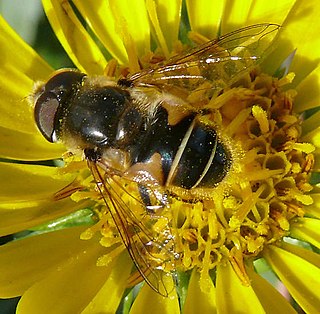
Eristalis hirta, the black-footed drone fly, is a common Western North American species of syrphid fly, first officially described by Loew in 1866. Hoverflies get their names from the ability to remain nearly motionless while in flight. The adults are also known as flower flies as they are commonly found on and around flowers, from which they get both energy-giving nectar and protein-rich pollen. The larvae are aquatic filter-feeders of the rat-tailed type.











